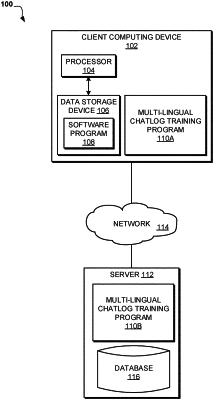| CPC G06F 40/58 (2020.01) [G06F 18/214 (2023.01); G06F 40/35 (2020.01); G06F 40/44 (2020.01); G06N 20/00 (2019.01); H04L 51/02 (2013.01)] | 20 Claims |

|
1. A processor-implemented method for multi-lingual chatlog training, the method comprising:
receiving, by a processor, a plurality of data related to conversational data in multiple languages concurrently;
assigning an intent label to each conversational data;
assigning a language label to each conversational data;
analyzing each piece of said conversational data based on available information including stored data logs, and dividing said pieces into a first group and a second group, wherein the first group comprises pieces of conversational data in at least a first language and a second language, wherein the second group comprises pieces of conversational data in at least a third language, and wherein the first group has more information and available data logs for the first language and the second language than the second group has for the third language;
pairing each piece in said second group with at least a piece in said first group, wherein said pairing is made based on similarity of said pieces;
said similarity being determined based on existing classifiers obtained from available information and said stored data logs, wherein said pairing is made using contrastive learning models based on the pieces of the conversational data in the first language, the second language, and the third language according to the intent label and the language label;
storing the pairings so as to provide each piece of said conversational data of said second group with a piece of said conversational data of said first group;
training a machine learning model using said pairings to provide a translation between the multiple languages in a multi-lingual and multi-intent conversational data pairing, wherein the machine learning model is also trained using a single language and multi-intent conversational data pairing;
and providing a multi-lingual chatlog according to the trained machine learning model.
|